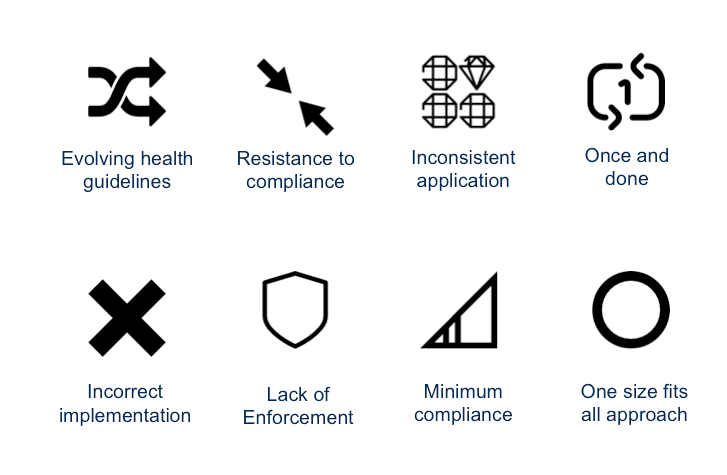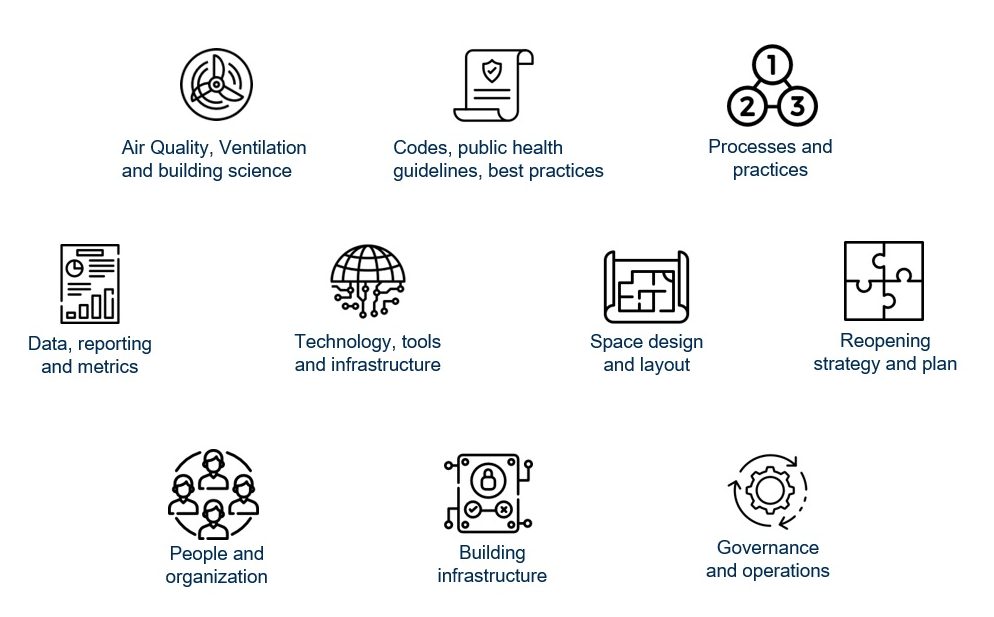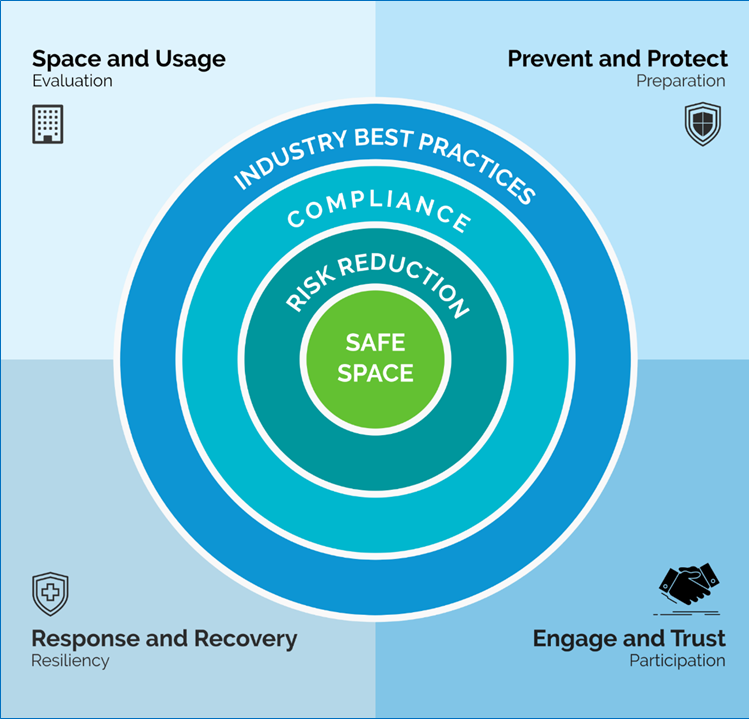Reopening and return to work initiatives accelerate in 2021 but concerns remain
The coronavirus COVID-19 pandemic has disrupted cities and communities worldwide. From the loss of lives, interruption of essential day-to-day services, to disruption of the global economy, no one person, organization or country is spared. In response, many organizations, businesses and schools, shifted to online operations and work from home. However, a larger number of businesses and organizations were closed, while a few “essential” organizations remained open with varying levels of restrictions.
The discovery, and regulatory approval, of two vaccines at the end of 2020 have put in motion plans for a wider scale economic and community reopening in 2021. Despite this, COVID-19 isn’t going away. It will take many months for the vaccine to be administered to the community. Some people have already stated that they will not be taking the vaccine voluntarily. None of the approved vaccines are 100% effective and there are at least three variants of the COVID-19 currently in the community. Finally, the vaccine protects against falling sick from COVID-19, but not against exposure and transmission.
As reopening looms, concerns about returning to and resuming in-person activities safely become top of mind. Planners must take a more holistic approach to create truly COVID-19 safe spaces that people will confidently return to. In this blog, we introduce the four elements that make a space safe, discuss the role of technology, and provide some practical advice in planning a COVID-19 safe space.
COVID-19 is transmitted in one of three ways
A proper discussion of return to work and safe spaces start with an understanding of the science of virus transmission. All viruses, including COVID-19, are spread in one of three possible ways – through direct contact, inhalation of respiratory droplets and inhalation aerosols (or micro-droplets).
Contact transmission occurs when a person picks up the virus through direct contact with an infectious person or from contaminated surfaces (fomites). Infection occurs when the person touches a contaminated surface, then touches their mouth, nose or eyes. Direct contact transmission is mitigated by frequent hand washing and wiping and disinfecting surfaces. The CDC has found that contact transmission is not a major contributor to COVID-19 infections.
Respiratory droplet transmission occurs when someone inhales the virus through exposure to respiratory droplets exhaled by a contagious person. Droplets are exhaled when breathing, talking, singing, sneezing and coughing. A sneeze can expel as many as 40,000 droplets. Singing, loud speaking, or heavy breathing during exercise are deep exhalation events that expel many more droplets than when we just breathe or stay quiet.
The droplets, though quite small, travel about six feet before settling to the ground due to gravity. This is the basis of the “6-foot rule” of social distancing. Because relatively large respiratory droplets can contain a considerable volume of viruses, this form of transmission is regarded as a potent source of infection. Droplet transmission is mitigated through the wearing of facemasks and social distancing.
Airborne transmission occurs when someone inhales the virus through exposure to micro droplets (or aerosols) exhaled by a contagious person. Unlike droplets, aerosols are much smaller and stay suspended in the air from minutes to hours. Aerosols can travel with the ambient air currents well beyond the six feet range of droplets. Aerosols are exhaled as well as formed from the larger droplets drying out and leave behind micro-droplets. The CDC has identified airborne transmission as a method of COVID-19 spread. Aerosol transmission is mitigated through facemasks, social distancing and proper air ventilation.
The design of effective COVID-19 safe spaces applies an understanding of these transmission mechanisms and implements corrective measures to mitigate transmission. As droplet and airborne transmission are the most likely causes of COVID-19 spread, effective safe spaces need to focus heavily on these mechanisms.
Safe reopenings start with COVID-19 Safe Spaces
While various federal and local governments have published guidelines and guidance on practices and requirements, many spaces are not safe for sustainable in-person activities for a variety of reasons (Figure One). People are reluctant to return to a physical setting because they don’t feel safe. Similarly, business and space owners are at risk if they don’t implement the proper measures.

A successful and sustainable reopening and resumption of in-person activities starts with safe spaces. A COVID-19 safe space provides peace of mind to employees, visitors, and employers. It is a physical space that enables people to come together to work, collaborate, learn, and socialize in a way that minimizes their health risk. A COVID-19 safe space prevents infected people or things from entering the space. It protects its occupants from any infection sources that may have entered the space. It mitigates the impact of any possible exposure inside the space. It responds quickly and effectively to actual exposure incidents. It recovers and returns the workspace quickly with minimal business or occupant disruptions.
Building blocks of COVID-19 Safe Spaces
A properly designed COVID-19 safe space incorporates ten building blocks (Figure Two).

Reopening Strategy and Plan. A return to work plan is required for reopening in many jurisdictions and is the basis for all prevention and response actions. The plan is specific to each space location, and includes a comprehensive risk assessment of the work spaces. This plan describes in actionable detail the “what, who, how, and when” of preventing and responding to COVID-19 exposure incidents. It includes various safety countermeasures, training, practices and processes put in place. To be effective, the plan needs to be updated on a quarterly basis.
Codes, Public Health Guidelines and Best Practices. Spaces and workplaces are subject to a variety of regulations imposed by various federal, state, and local public health and government agencies. Guidelines from the CDC and ASHRAE, as well as industry best practices provide additional guidance on various practices, policies, and measures to promote further safety. These codes must be translated into actionable measures for a specific space.
People and Organization. Leadership commitment is vital to the sustainability, effectiveness and health safety of the facilities and its day-to-day operations. This building block includes resources and budgets, staff roles, responsibilities and accountabilities, knowledge and skills, engagement, communications and trust building. The best health safety measures will fail if people and the organization do not comply, or are properly trained, or don’t follow the policies and practices.
Processes and Practices. Policies become real and actionable when they are implemented in processes and practices. These policies, and corresponding processes and practices, may be specific to a particular space. This building block spans a wide range of topics from hygiene, in-person interactions, on-site behavior and rules, staffing levels, work from home, response to exposure incidents, communications, and so forth.
Governance and Operations. The ability to manage and address COVID-19 related issues and safe space performance is necessary to respond in an agile and effective manner in a fast changing environment. This capability is enabled by effective and empowered organization and team structures, policies and decision-making processes, and augmented by metrics and dashboards and tools.
Building Infrastructure. This block is concerned with the permanent or built-in elements of a building that can be used to create a safe space. Building infrastructure includes the elevators, entry access control systems, building automation systems, HVAC systems, security and video cameras, telecommunications equipment, digital network, and so forth. For example, the digital network can be utilized to connect occupancy sensors across the building. Video feeds from camera systems can be processed by artificial intelligence algorithms to monitor compliance with facemask wearing, social distancing, group size and gathering time.
Space Design and Layout. A space’s physical design and characteristics determines its inherent COVID-19 safeness. The level of safeness will also be dictated by the types of activities conducted in the space, the demographics of its occupants, and usage patterns. A bar is inherently less safe than an office building. An office building with a high flow of outside visitors is less safe than a similar size office with no outside visitors. Reconfiguring, de-densification and changing how the space is used are possible options to make a space safer.
Ventilation, Air Quality and Building Science. Respiratory droplet and airborne transmission are key transmission mechanisms of COVID-19 inside a space. The indoor air quality environment is a major contributor to the safeness or riskiness of a space. The ability to characterize the indoor ambient air environment, including movements, dead spots and ventilation, and to translate those into effective tactical actions, is vital to the protection of occupants.
Data, Reporting and Metrics. The performance of the safe space must be continuously monitored so that areas of concern (and opportunity) can be addressed quickly. The ability to understand how a space is doing is key to reducing risk and preventing exposure and infections. Data, from a variety of sources, from sensors to incident reports, must be captured, aggregated, analyzed and presented for management and staff attention in a timely manner.
Technology, Tools and Infrastructure. The use of technology provides the automation, execution and verification of the processes and policies. It simplifies tasks, reduces staffing resources, eliminates risky tasks, and enables timely execution. Technology covers a broad category of things and may be in the form of sensors, kiosks, software, digital signage, automation tools, remote working applications, and so forth. Understanding how, where and when technology is used and integrated in the space and company systems will enable to COVID-19 resilient.
The COVID-19 Safe Spaces framework
The ten building blocks are then organized into four major areas of focus as to form the COVID-19 Safe Spaces Framework (Figure Three):
Space and Usage. This area of focus is concerned with the physical characteristics of the space, the types of activities conducted inside the space, the demographics of its occupants, its interior design, and the environmental and air quality characteristics. These factors determine the overall safeness and suitability of a space for in-person activities. Strategic intervention in some of these factors are critical in reducing the risk levels of a space.
Prevent and Protect. A series of thoughtfully planned and executed measures within a workspace plays a significant role in proactively reducing the potential infection risk within a workspace. Five broad types of measures are employed – workspace safety plan, training and knowledge of its occupants, roles and responsibilities, policies, and practices, and uses of technology. An effective safe space incorporates a number of specific tactics evenly across these five factors to ensure a space is proactively operated and maintained for safe in-person activities.
Respond and Recover. Despite the rigorous and thorough application of various measures, the potential of an infection incident occurring in the workspace exists. An effective COVID-19 safe space plans for this possibility, and employs a variety of measures to help respond, and quickly return the space to its original “safe” state. Four broad types of measures are available – management and coordination, policies and processes, implementation of policies and processes, and use of technology. A set of diverse tactics, spread across the four measure categories, are necessary for a truly safe space.
Engage and Trust. This is an often overlooked, but strategically vital, component of a safe space. A workspace is only as safe as the trust and perception of safety its occupants have in it. A workspace can implement the most advanced measures to protect its occupants from infection risk, but if its occupants don’t feel safe, then it is not safe and they will not physically return. And for those who return, management needs to be sure they will follow the safe workspace plan and protocols that have been developed. Five broad types of measures are available to increase engagement and trust of a workspace – leadership and commitment, reporting and metrics, communications and engagement, resources and tools, and trust building. An effective safe space incorporates a number of key tactics evenly across the five measure categories.

Best practices for planning COVID-19 Safe Spaces
In order to build your COVID-19 safe space in support of reopening and return to work, it is critical to first take a step back and assess your current physical space, return to work initiatives, health codes and guidelines, organizational readiness, resources and capabilities. The assessment will provide you with a baseline understanding of the “safeness” state of your space, the gaps, and areas to focus efforts on.
Focus your assessment described in the four areas listed in the COVID-19 safe space framework (Figure Three). The findings from the assessment will be the starting point used to identify the requirements needed to design, build and operate the COVID-19 safe space.
As you plan your COVID-19 safe spaces, consider the following:
- Incorporate a holistic approach to creating a COVID-19 safe space that includes technology, people, policies, practices and processes, building infrastructure, space design and layouts, building and health codes, and government guidance and best practices.
- Make occupant/tenant peace of mind a priority by establishing confidence and trust in your COVID-19 safe spaces from the start. Tactics include but not limited to continuous occupant engagement and communications, prominent placement and display of visual cues of operating countermeasures, rapid response to incidents, and other measures of reassurance.
- Create a “day in the life” perspective of an occupant in discovering the full range of potential opportunities for creating a more complete COVID-19 safe space.
- Ensure budgeting for every improvement area is handled now and set for at least 24 months.
- Review your COVID-19 safe space plans and classify measures into one of five functional capabilities – prevent, protect, mitigate, respond and recover. An effective plan and space have capabilities in each of these five areas. Avoid the common mistake of focusing efforts on one or two areas.
- Invest in occupant capabilities and readiness to operate and work in a COVID-19 safe space. Even the best countermeasures are ineffective if occupants don’t put them into practice. Readiness assurance activities include, but not limited to regular training, drills, change management, assignment of roles, responsibilities and accountabilities.
- Complement specific countermeasures with its corresponding policies, practices, and processes to ensure maximum adoption and operation of COVID-19 safe spaces.
- Stay current on evolving building and health codes. Develop a futureproofing plan that enables the space to incorporate and accommodate new codes and best practices as they develop. If no codes exist at the moment, review government guidelines (e.g. CDC guidelines) and incorporate into your COVID-19 safe spaces.
- Incorporate a balanced mix of physical, technology and building infrastructure countermeasures to create maximum effectiveness. Physical countermeasures include floorplan layout and design, special furniture, and space de-densification. Technology countermeasures include monitoring sensors, touchless systems and so forth. Building infrastructure countermeasures include implementing changes to HVAC operations and systems, minimization of contact on shared infrastructure (elevators, doors, etc.).
- Secure executive support for the creation of COVID-19 safe spaces. The most effective safe spaces have sustainable funding, adequate resources, organization wide support, and executive oversight and visibility.
This concludes Part One. In Part Two, we discuss the integral role of technology in the operation and maintenance of the Safe Space.
Credits
This blog was a collaborative effort and co-authored with the following:
Benson Chan, Senior Partner, Strategy of Things
Craig Stark, Managing Director, Strategy of Things Canada
Dr. Peter Williams, Partner, Strategy of Things
Dr. Manfred Zapka, Chief Operating Officer, Great Places and Spaces
Dr. Phyllis Horner, Chief Executive Officer, Great Places and Spaces
The COVID-19 Safe Spaces Framework was jointly developed by Strategy of Things, Great Places and Spaces, Peter Williams Consulting and Change Impetus Ltd.
Thanks for reading this post. If you found this post useful, please share it with your network. Please subscribe to our newsletter and be notified of new blog articles we will be posting. You can also follow us on Twitter (@strategythings), LinkedIn or Facebook.
Related posts:
Creating COVID-19 Safe Spaces for Reopening and Return to Work (Part Two)
Case Study – Silicon Valley City Reopening Readiness
Managing Indoor Air Quality with IoT in a COVID-19 Safe Space
Online Smart City-Solutions Provider Collaboration Framework for COVID-19 Response
Responding to COVID-19: A framework for smart cities
A new beginning – the COVID-19 New Normal


5 thoughts on “Creating COVID-19 Safe Spaces for Reopening and Return to Work (Part One)”